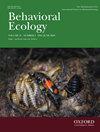The strength of sexual signals predicts same-sex pairing in two Coptotermes termites
IF 2.2
3区 环境科学与生态学
Q2 BEHAVIORAL SCIENCES
引用次数: 0
Abstract
Same-sex sexual behavior (SSB) is an enigma in behavioral ecology as it does not result in reproduction. Proximately, the effect of sexual signals on SSB could be distinct between signal receivers and senders. For receivers, the absence of sexual signals leads to smaller phenotypic sex differences, leading to frequent accidental SSB between receivers. Alternatively, for senders, sexual signals could help locate another sender, enhancing intentional SSB. Here, we demonstrate this link between sex pheromone signaling and the frequency of same-sex pairing in two Coptotermes termites that use the same chemical as sex pheromones but in different quantities. In termites, mating pairs engage in tandem runs, where a female emits sex pheromones to guide a male as they move together in searching a potential nest site. So, females are signal senders, and males are signal receivers for sexual communication. We found that female-female tandems were more stable in C. formosanus, whose females produce more pheromones. On the other hand, although both species did not show stable male-male tandems, males of C. gestroi, whose females produce fewer pheromones, spent more time attempting to follow another male. Thus, stronger pheromones lead to sender-sender SSB, while weaker pheromones lead to receiver-receiver SSB. The proximate mechanism of SSB is diverse according to the properties of sexual communications in heterosexual contexts.性信号的强度可预测两只白蚁的同性配对
同性性行为(SSB)是行为生态学中的一个谜,因为它不会导致繁殖。性信号对同性性行为的影响可能在信号接收者和发送者之间有所不同。对于接收者来说,没有性信号会导致较小的表型性别差异,从而导致接收者之间频繁发生意外 SSB。或者,对于发送者来说,性信号可以帮助定位另一个发送者,从而增强有意的 SSB。在这里,我们在两种使用相同化学物质作为性信息素但数量不同的白蚁身上证明了性信息素信号与同性配对频率之间的这种联系。在白蚁的交配对中,雌性白蚁会发出性信息素,引导雄性白蚁一起寻找潜在的巢穴。因此,雌性是信号发送者,雄性是性交流的信号接收者。我们发现,雌鸟与雄鸟的串联更为稳定,因为雌鸟能产生更多的信息素。另一方面,虽然这两个物种都没有表现出稳定的雄-雌串联,但雌性信息素分泌较少的盖斯罗伊蝇的雄性花了更多的时间试图跟随另一只雄性。因此,较强的信息素会导致发送者与发送者之间的 SSB,而较弱的信息素会导致接收者与接收者之间的 SSB。根据异性环境中性交流的特性,SSB 的近似机制是多种多样的。
本文章由计算机程序翻译,如有差异,请以英文原文为准。
求助全文
约1分钟内获得全文
求助全文
来源期刊

Behavioral Ecology
环境科学-动物学
CiteScore
5.20
自引率
8.30%
发文量
93
审稿时长
3.0 months
期刊介绍:
Studies on the whole range of behaving organisms, including plants, invertebrates, vertebrates, and humans, are included.
Behavioral Ecology construes the field in its broadest sense to include 1) the use of ecological and evolutionary processes to explain the occurrence and adaptive significance of behavior patterns; 2) the use of behavioral processes to predict ecological patterns, and 3) empirical, comparative analyses relating behavior to the environment in which it occurs.
 求助内容:
求助内容: 应助结果提醒方式:
应助结果提醒方式:


